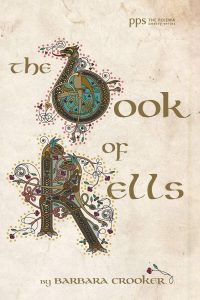 Review by Tasslyn Magnusson
Review by Tasslyn Magnusson
The Book of Kells, by Barbara Crooker, opens with the evocative line, “Night opens its woven basket,” (3) from the poem “Samhain.” This was unexpected and delightful. Unexpected as when the “Introduction” describes the Book of Kells as one of the most spectacular examples of illuminated manuscripts and is “widely regarding as Ireland’s finest treasure,” (ix), I thought I’d be reading more traditionally analytical text. Delightful, as once I read those lines, I knew that Barbara Crooker would be using the powerful tools of poetry to explore and analyze this extraordinary document.
Not that historical analysis isn’t important. I’m a historian by training and a poet by choice so I am fascinated by all the ways we can talk about the past, our relationship with the past and lately its been about how poetry can illuminate the emotional resonance of the past in our own present. But lately I’m more interested in the ways poetry can transform our analytical eye – which made The Book of Kells an exciting read.
The Book of Kells is a series of poems in conversation with a unique illuminated manuscript. Although we can say “poetry paints a picture with words”, it is a challenge to consider centering poems on a book that is primarily visual. Crooker addresses this complexity through a variety of means, but the persona poem “Cat in Folio 280R” is especially terrific. The cat on the page, as our guide, positions us, the reader within the picture of this illuminated manuscript. “I’ve a place / of my own on this strong piece of vellum, / four lines from the top, the best part of the page,” (17). The cat brings us into their page. “My garden’s a heaven of strokes in a row / made by ink and the sharp tip of a feather – “ (17).
In another poem, “Interlinear,” Crooker writes a praise poem to the animals that “flit here and there in the Vulgate text, / who can wedge in small places,” (13). Describing a variety of ways animals are used in the book, including as punctuation, Crooker’s poem transforms into a praise poem for all creatures. She writes, “So let us praise all of God’s creatures, / including the small and inconsequential, all of us, / interlinear, part of the larger design,” (13). While pulling the reader into the experience of the page, she simultaneously asserts a place in a universe for all of us.
Crooker divides her book into four parts. Part One focuses more closely on the manuscript. Party Two explores the landscape of the manuscript – Ireland. Part Three centers on Crooker’s meditations on and relationship with The Book of Kells. Part Four really interested me. It is where the reader – and Crooker – begin the journey home from the manuscript. At first, we move into the landscape around the book – Ireland. And slowly Crooker’s poems begin to ponder a return. And like the traditional “hero’s journey” it is a return where Crooker is transformed by the journey. Like the monks who illuminated the manuscript, she too but sit “empty-handed, open-hearted, / scratching black lines on yellow paper, and hoping that somehow, / like the newly-hatched frogs in the ornamental pond / I will be able to croak my way into song,” (63).
While I was deeply fascinated by the construction of the collection and Crooker’s project exploring this manuscript, The Book of Kells also contains some just gorgeous lines that build to beautiful poems. These poems stand alone as well as part of the whole. For example in “Whooper Swans” Crooker writes, “In Monaghan / they say / there are no / horizons,” (39). And from that opening, the poem stretches down the page, moving us with the swans through the poem. And in “Laundry,” Crooker examines the intimacy of a marriage that is “all sixes and sevens, not taking time to talk / or touch,” (50). The alliteration and the line break are beautiful examples of using the sound to create emotional setting for this story.
The Book of Kells is great craft work, gorgeous lines, and what Crooker does most elegantly – use tools of poetry to analyze and examine. I need more poetry collections like this in my life.
The Book of Kells by Barbara Crooker
Cascade Books 2018; paper, 88 pages.
ISBN 978-1532606380
Tasslyn Magnusson received her MFA in Creative Writing for Children and Young Adults at Hamline University in Saint Paul, MN. Her poems have been published or are forthcoming in Broad River Review, Room Magazine, Mom Egg Review, The Raw Art Review: A Journal of Storm and Urge, and Red Weather Online. Her chapbook, “defining,” from dancing girl press was published in January 2019. She lives in Prescott, WI with her husband and two kids and two dogs.
